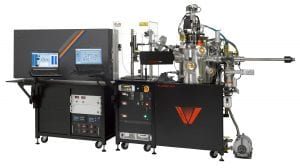PLD/MBE 2300
The PLD/MBE has a 248nm KrF excimer laser; Coherent CompEx Pro 102F.
The system has the following capabilities:
- Laser Power: 90 – 300 mJ / pulse at the laser (~30% lost along optical train)
- Repetition Rate: 1 -20 Hz
- Spot Size ~ 7 mm2 (larger and smaller spot sizes are possible by lens adjustment)
- Target – Substrate Separation: 50 – 100 mm
- Adjustment of Lateral Position of the Laser Pulse Relative to the Substrate
- Deposition Atmosphere: 2×10-7 and 1 Torr (O2, N2, Ar, or mixed gas)
- Substrate Temperature: 25°C to 800°C
- Samples as large as 2” diameter
- Load Lock for quick pump-down
- Multilayer and Superlattice Deposition (See Techniques Section)
- Custom Composition Films from Two or more Targets (See Techniques Section)
- Combinatorial Film Deposition with up to four targets (See Techniques Section)
- Multiple Thickness in a Single Deposition (See Techniques Section)
- Linear Composition Gradient of Two Materials (See Techniques Section)
The PLD/MBE is reserved for materials with low vapor pressures. The staff can quickly determine if a material of interest can be deposited in the PLD/MBE. If it cannot, there is a high probability it can still be deposited in the PLD facility using the nanoPLD.
Please check here for pricing information.
Staff contact for this instrument: D. Bruce Buchholz
nanoPLD 1000
The nanoPLD 1000 has a 248nm KrF excimer laser; Coherent CompEx Pro 102F.
 The system has the following capabilities:
The system has the following capabilities:
- Laser Power: 90 – 300 mJ / pulse at the laser (~30% lost along optical train)
- Repetition Rate: 1 -20 Hz
- Spot Size ~ 7 mm2 (larger and smaller spot sizes are possible by lens adjustment)
- Target – Substrate Separation: 50 – 100 mm
- Adjustment of Lateral Position of the Laser Pulse Relative to the Substrate
- Deposition Atmosphere: 2×10-7 and 1 Torr (O2, N2, Ar, or mixed gas)
- Substrate Temperature: 25°C to 800°C
- Samples as large as 2” diameter
- Load Lock for quick pump-down
- Multilayer and Superlattice Deposition (See Techniques Section)
- Custom Composition Films from Two or more Targets (See Techniques Section)
- Combinatorial Film Deposition with up to four targets (See Techniques Section)
The nanoPLD has been used for a variety of higher vapor pressure materials including zinc compounds, lithium compounds, bismuth compounds, ruthenium compounds, sulfides and selenides to name a few.
Please check here for pricing information.
Staff contact for this instrument: D. Bruce Buchholz

